Posted by Horst Nitz on 12-17-2006 08:06 AM:
A Splendid Rug
Hi all,
Before we are completely wrapped up in Christmas preparations,
would you like to take a closer look at Cat. 4 with me?
This is the
unique 16th century triple medallion rug from Anatolia in the Black Church,
Brashov, 148 x 202 cm, 1300 kpsdm, on which Christine Klose focussed in her
presentation, and which Alberto Boralevi ‘looking mainly to the colours’
attributed to the Karapinar area in Central Anatolia. Also, as it said in the
handout to his presentation, this is probably the ‘most intriguing and most
interesting piece in the whole collection.’

Apparently, the rug
has in the past been widely discussed by several authors (Jon Thompson 1980,
Christine Klose and Ali Riza Tuna at 6th ICOC Hamburg). ‘All of them have
noticed the resemblance between the pattern of this piece and that of classical
Turkmen carpets.’ This is how Christine Klose acquainted us with this
perspective:

The image shows an endless repeat pattern familiar from
classical Turkoman rugs; varying the field-sector allows for design alternatives
that look astonishingly different:

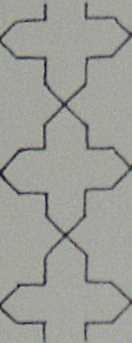
In the case of ‘our’
rug three cruciforms on the same axis appear to have sintered into one body,
flanked by two half-göls and two quarter-göls on either side. What appears as
being unique to us, actually may have been not quite as much out of the ordinary
in the 16th century.
I am indebted to Christine Klose for providing the
following image in the course of the preparation of this essay. It shows rug
A-28 of the Vakiflar Museum Istanbul; judged by its appearance, from
east-central or eastern Anatolia and perhaps a contemporary of CAT. 4 – with a
size of 380 x 210 cm a rather large rug. Especially noteworthy is the similarity
of the cruciforms in the two rugs, an observation on which Christine Klose built
her Timurid tradition hypothesis.
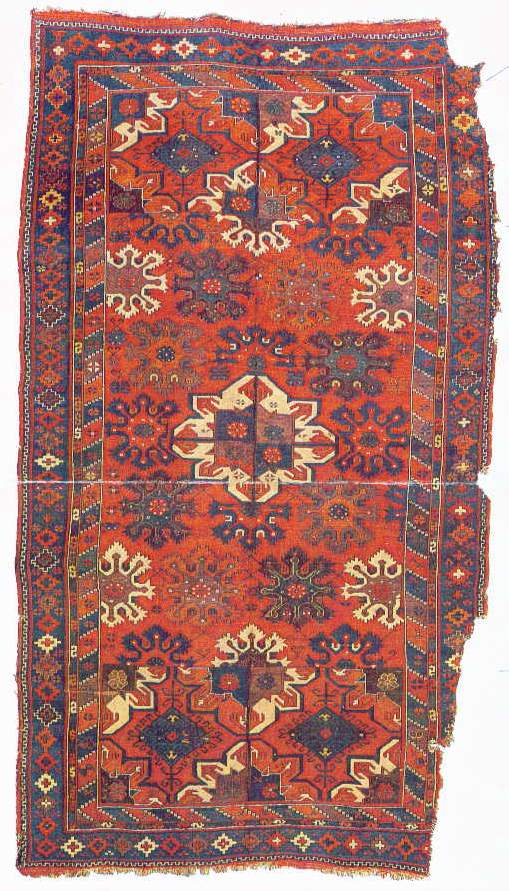
A number of other
interesting thoughts and images in this context provides Dennis Dodds (1986 ?)
Truly Classical. Hali 39, pp 17-22, when he discusses the connection between
East Mediterranean designs of the Classical period and early Anatolian rugs with
reference to a fragment of a Sivas area weaving in the Bertram Frauenknecht New
York exhibition:
‘While much is known about the westward migrations of
Turkic peoples and their contributions to the design vocabulary of the weaving
cultures that they influenced, the role of the entrenched, resident cultures who
were dominated by the Turks and by Islamic people in general is less frequently
discussed. When observing form and style in the art of this region, it is
particularly important to understand that Islam borrowed frequently and
enthusiastically from the decorative conventions of existing local cultures.’
This about hits the nail on the head is the background against which
CAT. 4 should be evaluated.
Whilst the triple medallion forms a rather
imposing figure, there is another more elusive cruciform contained in the border
of the rug, under what appears to be gables forming an integrated part of
reciprocal trefoils, perhaps an early and sophisticated medachyl form. The
repeated cruciform in the border is tiny, only a few knots and one weaving line
wide on both axes:

It is difficult to say, what its significance is. At first
sight I thought of anchors, what doesn’t seem to make much sense – perhaps an
anther with petal and calyx? A similar motive appears on the 16th century Sivas
area pile rug fragment discussed in the Dennis Dodds article, and maybe does so
as part of various renditions of the tauk noshka and other Tukoman göls (as a
border design see plate 201, a Tekke torba, in Eiland and Eiland (1998) Oriental
Carpets. Page 230. In the same book, also highly interesting in this context,
plate 186, an early Turkoman rug with design features that link it to north-west
Persia, according to the authors.
The following image is derived at by
processing the half-göl forms of Cat. 4. The result looks all the more like the
central göl in Vakiflar A-28:
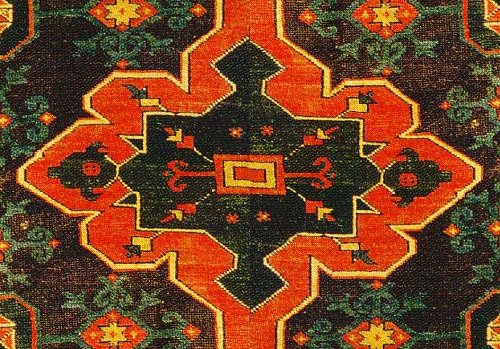
Until the
middle of the 20th century rugs with large central medallions that can be
regarded as being related to ‘our’ göl have been produced in an area described
as the ‘Yörük Triangle’ – Yohe R S (1979) Rugs of the Yörük Triangle. Hali II/2,
pp 113-120; Görgünay N (1971) Doguyöresi Halelari. Türkiye Is Bankasi Kültür
Yayinlari, Sanat Dizisi23, Ankara.
This is how Ralph Yohe defines the
‘Yörük Triangle’: Look at a map of Turkey. Draw a line from somewhere north of
Tokat (northeast of Sivas (more precisely, Tokat is situated north-northwest of
Sivas, H.N.)) eastward just north of Erzurum to somewhere between Agri and Kars.
Then trace it southwesterly to Diyarbakir, Gaziantep and Adana. Extend the line
northward, just missing Kayseri to the west, back to the spot where you
begun.”
The population, now mainly sedentary and assimilated to various
degrees, has origins in a variety of ethnic groups, Kurds, Turkomans, Tatars,
Afshari, Circassians, Armenians etc.
Could it be possible to link Cat. 4 to
any of them?
(To be continued)
Regards,
Horst Nitz
Posted by Sue Zimmerman on 12-17-2006 12:48 PM:
More splendid still?
Thank you, Horst, for your closer look. Here's another one.
Please
look at the "quarter-gols" in the splendid rug's field corners. In each corner
is the silhouette of a red-eyed fetal dragon, isn't there? Has anyone spoken to
that? Sue
Posted by Richard Larkin on 12-17-2006 01:16 PM:
Hi Horst,
This is wondersul stuff. More! More!
__________________
Rich
Larkin
Posted by Patrick Weiler on 12-17-2006 10:01 PM:
Cousins?
Horst,
The rug you show as A-28 from the Vakiflar Museum has a very
familiar gul in the center. It is quite a lot like a common Khamseh Basiri
design. A version of it can be seen on a bag face in this early Salon, just
below the Baluch balishts, picture number 7:
http://www.turkotek.com/salon_00045/salon.html
A-28 has
a quartered center, but this Khamseh type is found with a plethora of central
designs, from the ubiquitous "endless knot" in the pictured Khamseh bag to a
variety of floral and geometric motifs.
The Khamseh Basiri are a mixed tribe
with some Turkic origins.
If I were to see a rug like this from the 19th
century, though, I would say it looks more like Afshar weaving, with the rather
wider size and particularly the diagonal border. I wonder if A-28 has depressed
warps like Afshars?
Patrick Weiler
Posted by Sue Zimmerman on 12-18-2006 12:28 PM:
Sorry, Horst,
The thing is is that this splendid rug has so many past
and future relatives that it's almost an overwhelming temptation to resist going
into comparison mode. The rug really deserves better, I think, on second
thought.
For one thing does pinpointing it's designation as being woven
anywhere, based only on it's color, pass for anything these days on a rug such
as this? If it does I think the party is over before it begins. If it doesn't,
and there is good structural analysis which has been done on it, that is the
real place to start analysis from if things are to be put into perspective
anytime soon -- as in any of our lifetimes. Has that been done? Is it available
to the public? Can you put it out here?
In the meantime, and this is only
a by the way type question, what the heck is this A-28 Vakiflar museum rug with
the Spanish looking gol? Is it a wargireh or something? Sue
Posted by Horst Nitz on 12-18-2006 03:57 PM:
Richard, Patrick, Sue,
I am glad you enjoy it. Patrick, this is
excellent visual memory you are demonstrating, as well as an introduction to my
next post. Sue, as to the dragons' red eyes blinking from the rug, even the
specs I put on were to no avail - I'll try again later with the help of a glass
of port.
As to structural analysis, I could try to find out with the help
of Stefano and the museum staff. However, when it comes to a 300 years plus time
gap between Cat. 4 and 19th century rugs available to us for comparison, the
often stressed rule of 'designs wander - structure stays' may not be strictly
applicable. I agree, the Karapinar attribution might not be the ultimative
answer.
Yes, Vakiflar A-28 looks rather experimental. Perhaps it can be
put down to the never ending East meets West experiment that had already been
played on rug stage for 500 years at the time of its creation.
Bye for
now,
Horst
Posted by Richard Larkin on 12-18-2006 05:01 PM:
Hi Sue:
With oodles of trepidation, I say: Dragon? What dragon?
Patrick:
I'm a life member of the South Persian rug fan club, but
I'm not so convinced of the connection between that Basiri motif and the #28
from the Vakiflar. On the other hand, the redolence of latter day Turkoman gols
in that thing really gets one's attention. No doubt, the connection has been
noted elsewhere. By the way, thanks for the opportunity to look in on that
excellent salon you put together on those Balishts. I'll go back to
that.
Horst:
"Splendid" is just the word for that piece. It's the
kind of rug that makes one want to forget about most of the others. The analysis
by Kristine Klose is most intriguing. I often find discussions of design
evolution and migration a bit tedious, but discerning the connection between
early anatolian weavings and later, disciplined Turkoman weaving is usually
interesting. Thanks again for the excellent salon.
__________________
Rich
Larkin
Posted by Wendel Swan on 12-18-2006 05:21 PM:
Hello Horst and all,
I agree that the Brasov rug is splendid, but I’m
having difficulty understanding the relationship between it and the drawings of
the classical “stars and crosses” pattern. The Brasov carpet does not have
either 8-pointed stars or conventional cross forms and I cannot find any
juxtaposition of even the most imaginative variation of them in that
rug.
At each end of the field in the Vakiflar carpet, there is what one
could construe as ornately stylized variance of the stars and crosses
pattern.
Indeed, there is a relationship between Turkmen weavings and the
stars and crosses pattern. I made reference to it in a lecture I recently
delivered to the New England Rug Society. Their newsletter reproduced some of
the images I showed in that lecture, one of which compares a well-known Chaudor
engsi and tilework from a 14th Century tomb in Samarkand. You can see that
comparison here:
http://www.ne-rugsociety.org/newsletter/rugl142a.pdf
In
that newsletter you can clearly see that Islamic art patterns can be seen in
various media.
Perhaps I’ve missed the point of including drawing of the
stars and crosses pattern.
Wendel
Posted by Steve Price on 12-18-2006 05:29 PM:
Hi Folks
I'm never sure, but I think this is the motif that Sue sees
as a red-eyed dragon.

I'm reluctant to read too much into it, since my first reaction
is that it's a cartoon locomotive coming straight at me. Note the cross on its
apex. Hmmm.
Regards
Steve Price
Posted by Richard Larkin on 12-18-2006 05:48 PM:
Hi Steve:
Thanks, I was looking in the wrong "corner within a corner."
The red-eyed dragon and the runaway locomotive interpretations are about equally
compelling, I would say. How about a salon on "Messianic symbolism and Wily
Coyote in the weavings of Eastern Anatolia?"
__________________
Rich
Larkin
Posted by Patrick Weiler on 12-18-2006 07:29 PM:
Pesky dragons!
At the very top of the field, just above the red outline of the uppermost of
the three main medallions, is a thick, blue "spandrel" on either side.
Note
that these spandrels contain several red spots and where the dark spandrels
notch into the red, towards the middle of the upper medallion at the very top of
the field, the dark blue appears to look like the head of a bird (or dragon -
because of the spots) with a red eye and a hooked beak, facing
down.
Caucasian Dragon rugs have dragons with spots in their bodies and this
may be what Sue is seeing.
These "dragons" are 1/4 of the half-guls
bordering the field, a composite of which is shown by Horst at the bottom of his
first post. This composite, though, does not contain dual dragon-heads, but
instead "anchors" at either side of the gul.
Patrick Weiler
Posted by Steve Price on 12-18-2006 08:10 PM:
Hi Pat
Perhaps Sue will pop in to clarify before too much time gets
spent trying to decide what she was talking about.
Steve Price
Posted by Richard Larkin on 12-18-2006 08:57 PM:
Patrick,
Of course. That's the fetal dragon, upside down. Fetuses,
like rugs, don't care whether they're right side up or upside down. Now, if we
can pin down Steve's locomotive, we're golden.
__________________
Rich
Larkin
Posted by Sue Zimmerman on 12-19-2006 12:24 PM:
HALLELUJAH!!!
Patrick, God love you, thank you, and hallelujah!!!
You not only
found the fetal dragons but explained them better than I was trying to figure
out how to! Sue
Posted by Horst Nitz on 12-19-2006 05:31 PM:
Hi all,
I love the funny cartoon locomotive. To me it is a promise of
things to come, playing the electric railway with the children after
Christmas.
Those dragons on the other hand are weird, as if the weaver or
designer has intended to play on our reflexes. There seems to be nothing in the
shape of the black composite medallion urging the shape he or she has given to
the figure. The very small red corners add to it, they make the difference
between an ordinary (a solid) corner solution and the sleek shape of what you
are suggesting. I've looked at the picture a hundred times and did not see it,
well scouted, Sue, Patrick. Three of the four red dots are actually small
Holbein knots, tells the better resolution image in the
catalogue.
Wendel, those black medallions are the same cruciforms as
those in A-24, only somewhat misshapen and sintered together. If you go down the
vertical axis there are nine eight-pointed stars within octagones; and six more,
that is three on either side of the axis within those individual medallion. In
other words, five within each of the individual medallions. All
clear?
Thanks for the interesting link to the New England Journal ( I
only new the medical one so far); I had a look in between patients today, and
will take a deeper one as soon as time allows.
Bye for
now,
Horst
Posted by Wendel Swan on 12-20-2006 03:52 PM:
Hello Horst,
I now understand why you made the comparison. I was
looking at the drawing as a tessellation comprised of two forms (the 8-pointed
star and the cross) so as to completely fill the plane without gaps or
overlaps.
The stars and crosses pattern is widely used in tiles, with one
example from Samarkand being in the NERS newsletter. Others have larger fields
similar in concept to the first drawing. Examples from one well-known set are
found in the V+A and in the David Collection that is at Boston College through
year-end.
While I understand the point, the principles of tessellation
aren’t really necessary to string together three or more medallions via
translation.
More interesting to me is the tessellation in the Vakiflar
rug formed by the blue outline at either end of the rug. That tessellation has a
relationship to the stars and crosses pattern, but one must look beyond the
decoration found within them.
Wendel
Posted by Horst Nitz on 12-22-2006 10:25 AM:
Hello Wendel, Hi all,
It took me some time trying to work out what is
meant with ‘tesselated’, as this turned out to be beyond the scope of my Concise
Oxford Dictionary; even the ‘Advanced’ version did not make it much clearer:
‘tesselated (adj) formed of small, flat pieces of stone of various colours (as
used in mosaic): a ~ pavement.’ I imagine it to be something like a
‘Terrazo-floor’, made up of small stones of various greys and browns etc., the
kind of suggesting funny figures which you have difficulty finding again on
second look.
Unfortunately, I got caught up it all sorts of competing
activities and it will now take until after Christmas, that I can introduce you
to ‘inductive-deductive’ research method and invite you on a reconnaissance
tour, that will lead us outside Ottoman Turkey, because that is where I expect
the key to the understanding of Cat. 4 can be found.
Best Wishes for a
Merry Christmas,
Horst
Posted by Wendel Swan on 12-27-2006 09:21 AM:
Hello Horst and all,
Some images for you to ponder:

On the left is a classic
example of the crosses and stars tessellation (2 forms) in tilework, with this
example being at the V+A. Another section is in the David Collection.
I
created the middle image from portions of the Vakiflar rug, joined so as to
create a variation of the stars and crosses pattern.
The last image
relates to the second drawing, but is far less interesting, at least in my
opinion, than the tesselllation.
Happy New Year,
Wendel
Posted by Sue Zimmerman on 12-27-2006 01:42 PM:
Hi Wendel, and Everyone,
These are nice to ponder but it is important
to remember that the mathematics behind the tiles' and the rugs' formatting
mostly preceded Islam's work in the field and so one expression of them need not
be derivative of the other.
On closer examination the Vakifar rug
formatting is different from that used in the tiles. An additional invisible
design formatting devise enters the equation in the rug that was not utilized in
the tiles. To understand this additional "third factor" one must look beyond the
"decorations" found within it, too, as both the "star" and "cross" motifs
intrude on it, making comprehension of it difficult.
This "third factor"
used in the rug, but not the tiles, is adjoining hexagons. The hexagon
formatting can be seen by temporarily ignoring the "crosses" as motifs so as to
see that the blue rectangles within the "crosses" share an outer border with the
"star's" guls to form the hexagons' diagonal outlines.
The vertical side
lines of the hexagon's outlines touch the vertical axis lines that run
vertically through, and beyond, the "cross" centers.
The horizontal
outlines of the hexagons are formed by the horizontal axis lines that run
horizontally through, and beyond, the "cross" centers.
In other words,
the math behind these compared ponderables differs in important ways.
Now
I'll just patiently wait for Horst to continue in hopes he intends to go on
about the splendid rug's gable birds so I don't have to. Sue
Posted by Horst Nitz on 12-28-2006 04:51 PM:
Hi all and thanks for your patience,
tesselation is clear to me now,
thanks, Wendel, for ‘untesseling’ (?) it. While both patterns seem to follow the
same ‘mathematics’, Sue, I agree, the rug looks wilder, less integrated. In the
case of the tile pattern assimilation of designs seems to have reached a stable
level, probably the result of skilled workshop practise; the rug design seems to
have not ‘arrived’ yet.
Back to Cat. 4 - what follows first is an
ultra-brief summary of ‘inductive-deductive’ method (the term in this context
being as experimental as is the method): confronted with a (rug-research)
question, a given structure (knowledge, individual brain, work-group knowledge)
is formulating a position (deduction), which may not be satisfactory (dilemma)
and requiring the assimilation of additional knowledge; the landscape of
potential information is sounded out or tested (induction), the echo or
resonance or answers are subjected to assessment and if satisfactory are
assimilated to the given structure (knowledge, individual brain, work-group
knowledge) which itself accommodates to the new evidence or
findings.
Process on the interface of known and unknown: define (as many)
occurrence (-s) as specific as possible, test or ‘sound out’, record and
compare; the more resonance on as many variables / occurrences as possible, the
more reliable the newly gained information.
In practice:
We have a
rug of typical village produce size (occurrence 1) with broad kilim ends
(occurrence 2), containing a triple-medallion-form (occurrence 3) with halo
(occurrence 4), made up from cruciforms like on some early Central Asian rugs
(occurrence 5) and göl-like shapes (occurrence 6) of a particular kind
(occurrence 7). We also have a meandering main border of a leafy kind
(occurrence 8), forming reciprocal gables (occurrence 9) under which locomotives
with a cross-shaped funnel are waiting to be let loose (occurrence 10). This is
for demonstration; we could include colour constellation, symmetry, the blue on
black ornaments being half göl, half star, the central stars within octagons
etc.
This is the resonance we get (pre-selected cluster):
Afshar
and other South Persian village rugs (occurrence 1, 2 - Tanavoli P (1988, 1991)
The Afshar Part 1 and 2, Hali 37, 57);
Wide variety of North-, West- and
South Persian village and nomadic rugs (occurrence 3):

South Persian
Afshar rug from Kerman province (occurrences 4, 6, 7, 8, 9, 10 – see
images):
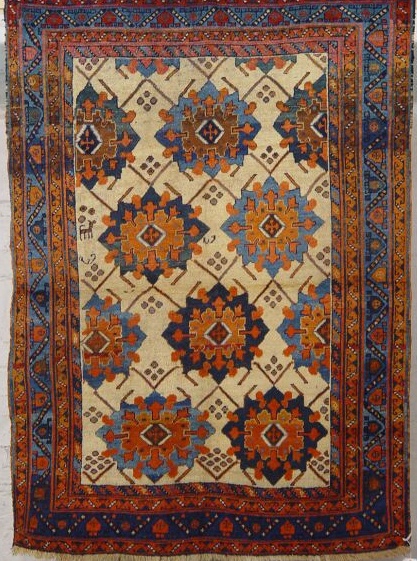
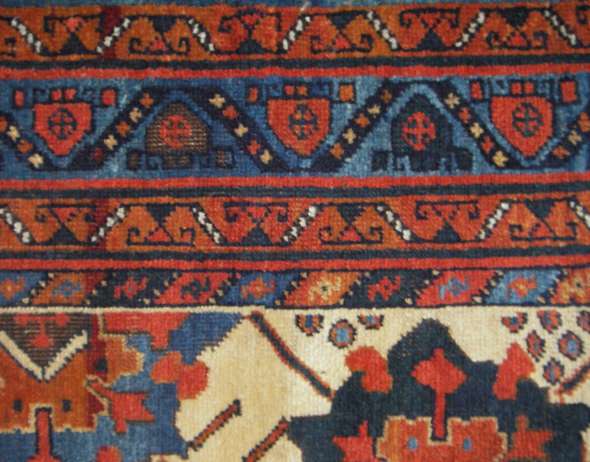

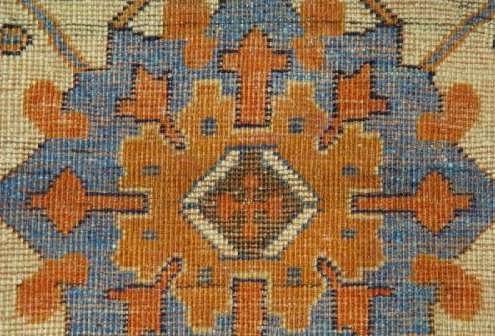
Vakiflar A-28 and another East Anatolian parallel rug,
apparently differing only with regard to the damage to the sides (occurrence 5,
6 – Ellis C G (1978) The Rugs from the Great Mosque of Divrigi; plate 28 Rug
with ‘Turkoman-gül’ design);
West or Northwest Persian Afshari rug
with a related, stylised border of same type (occurrences 8, 9,
10):


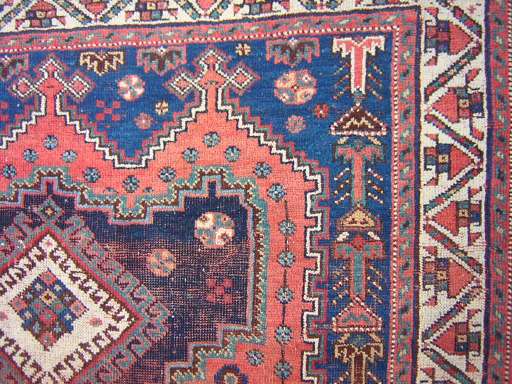
Considering a 300 - 350 years time gap between Cat. 4
and the late 19th / early 20th century reference rugs, the ‘echo’ is remarkably
stable. The South Persian Afshar rug with ‘Turkoman Göls’ from Kerman province
resembles at least one rug closely, that is depicted in the Ralph Yohe article
on the Yörük triangle (fig. 7). Divrigi with its Ulu Cami, one of the reference
locations, is a few hours east by railway from Sivas towards Erzincan, deep in
the Yörük triangle.
Of the ethnic groups mentioned by Ralph Yohe, one
more than any other it seems can be associated with Cat. 4, the Afshari, one of
the original invading Oghuzs, who for centuries had settled in East Anatolia and
Azerbaidjan, before the Azerbaidjani factions were resettled south in recurrent
waves, taking designs with them, that went on being woven by their Anatolian kin
for a long time, possibly until the middle of the 20th century.
This does
not per se exclude the possibility that the loom on which the rug was made was
set up somewhere in West or Central Anatolia. We know from earlier discussions
here how the eventual realisation of influences due to past tribal movements
have played havoc with neat attribution ideas, i.e. East Anatolian or Caucasian
designs in the Aegean region (Kazak-Kosak) - but here it works for us and makes
an East Anatolian or Azerbaidjanian attribution much more likely (some rugs may
have been made far west, whilst the design’s origin is in the east).
I am
aware, that the attribution put forward here, may lead to other question, i.e.
the validity of a Karapinar label and, possibly, the attribution to West
Anatolia of a number of other rugs of the ensemble. This may be for future
consideration.
Regards,
Horst Nitz
Posted by Sue Zimmerman on 12-29-2006 12:11 PM:
Horst,
The overlay of an invisible hexagonal formatting was not
utilized, nor necessary, in the tile work's design. The problems within the rug
Wendel compares the tile work to are a whole different, and very interesting,
story.
I was trying to explain why a comparison between the tile's and
rug's design formatting was an apples and oranges comparison. So that point was
missed.
The comparisons you are now making resonate only with Wendel's
comparison, to me. I don't see any application that can be made with these
comparisons in understanding the splendid rug. Nor do I know what to do about
such misunderstandings other than to point them out. Sue
Posted by Horst Nitz on 12-31-2006 02:19 PM:
Hello Sue,
I've tried more than once but seem to be unable to get the
knack of it: 'invisible hexagonal formatting was not utilized, nor necessary, in
the tile work's design ...'. I don't know whether it is my limited command of
English or eye-sight or something else. I may have to let this one pass this
year. 
Wishing all
of you a Happy New Year,
Horst
Posted by Sue Zimmerman on 01-06-2007 02:57 PM:
As an interesting aside, the real "experimental" Vakifar rug, as seen without
computer manipulation, reveals an attempt to reconcile it's mathematically
derived differing hexagonal formats, (as shown visually expressed in it's
differing motif areas), unsuccessfully.
This clash of hexagon formats
can be most clearly seen in the area of the four central horizontal motifs of
the rug. The "invisible" differently formatted hexagon's outlines being found in
the surrounding red field between the motifs. The Vakifar rug looks, to me, like
a failed math problem made visual.
I find this "experimental" rug rich
in lessons. For one thing understanding what went wrong bypasses, for observers,
having to actually know the math equations which would have led to a successful
resolution of it's rather simple "story problem". That something of a more
abstract nature was lacking is undeniably visually apparent in this rug. It
points out that the weavers of this rug did not have access to what would have
allowed smooth resolution of the sizing disparity of it's two hexagonal "3rD
factor", (as I'll now call it,) formatting, (amoungst other things I'll not
touch on here).
"Traditional" methods of formatting, even within
traditions where this 3rD factor formatting tradition was used, as it apparently
was for these weavers, whether learned by counting knots, other forms of rote
memorization, or knowledgeable "over the shoulder" guidance, etc., when
presented with merging and/or reorganizing motifs, from even equally
knowledgeable parallel traditions, or even from within one unparted tradition,
the abstract basics behind the designs are necessary to call upon, sometimes, as
they were for this rug, and clearly here, the call was unanswered.
There
are implications far and wide in this rug, in other words, as worthy of further
exploration in rug studies as any other pursuit, as I see it, because it is of a
fundamental and overarching nature. That is why I am attempting to share it here
despite it's off topicness.
For those who would like to give it a try but
don't understand what I'm trying to say, here's what you can do, on the cheap.
Print out a copy of the "experimental" rug. Tape tracing paper over it and
connect up the "3rD" factor of the formatting, the hexagons, with a pencil and a
ruler for further contemplation.
For those who cannot see any reason to
try to understanding this concept, or dismiss it entirely, here's something easy
to contemplate. A two dimensional drawing of a hexagon can be thought of as the
silhouette of a three dimensional cube. Draw a hexagram and then add the lines
necessary to make it a cube. Now open a rug book and compare your drawing to,
say, what appears within a good old Salor Kejebe motif, for instance. Some will
get it, I think. A few, those who like old Turkmen chuvals, for instance,
already have caught on, but maybe I'm wrong. Sue
Posted by Horst Nitz on 01-15-2007 03:51 PM:
Hello Sue,
the hexagon as the projected silhouette of a cube, an
interesting idea and something I have never thought of, or have forgotten of
since school days. However, what is the significance of it in this context? I am
sorry, I can't make head or tail of what you are
saying.
Regards,
Horst Nitz
Posted by Horst Nitz on 01-28-2007 12:35 PM:
Dear all,
I am very grateful for having received structural data on
the 3-medallion rug cat. 4. from the Black Church in Brashov. This I would like
to contrast with data on the Vakiflar A-28 rug from Balpinar B & Hirsch U
(1988) Carpets of the Vakiflar Museum Istanbul, that we have been discussing; to
make this threesome complete, I shall use data on one of the not too many
published Afshari rugs that come with such: plate 10 from Tanvoli P (1991) The
Afshar, Part 2. HALI no 57, June 1991, pp 96-105 (below):
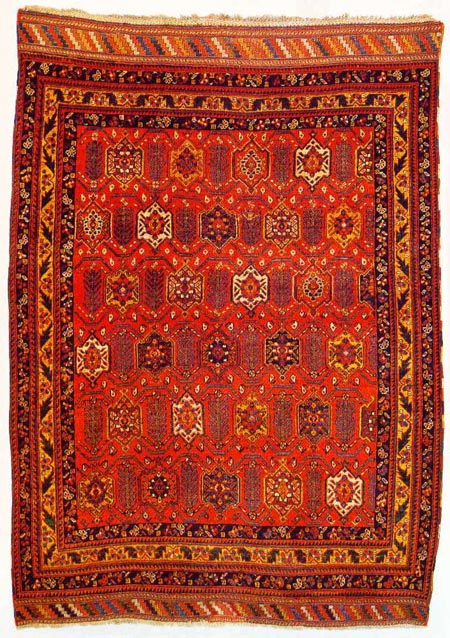
Structural data is
given as presented by the authors.
Cat 4:
Warps Z2 ivory wool
moderate compression
Wefts wool Z red-brown, two shoots, one straight, one
sinuous
Knots Gjordes (Sy) wool Z, 2-5 mm, 28-30 x 35-38, partly corroded
dark-brown
A-28:
Warps Z2S ivory wool
Wefts wool Z light red,
2-3 shoots, sinuous
Knots 2Z Sy1, 23 H x 32 V, 736 kpsdm
Plate
10:
Warps ivory wool Z2S
Wefts wool Z red two shoots, one straight,
one sinous
Pile Sy wool Z 4-5 mm, 40 H x 36 V, 1440 kpsdm
As you
can see there is not much in the way of contrasting structural data. It is all
rather similar. The ivory grounded Afshari rug with Göls and a sort of
Chintamani and lattice-ground design presented further up, shares these
structural features.
This suggests that the rugs discussed here share
much of their ancestry, which appears to have its starting point - as far as age
attribution is concerned and, taking into account what was said further up - in
East-Turkey and West Azerbaidjan.
Regards,
Horst Nitz
Posted by Steve Price on 01-30-2007 01:31 PM:
Hi Horst
That's a great demonstration of chasing down substantial
evidence and applying it to test a position. Rugdom would benefit from lots more
of this kind of analytical thinking.
Regards
Steve Price


















